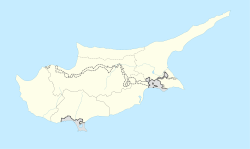Idalium
Ιδάλιον | |
 Map showing the ancient city Kingdoms of Cyprus. Idalion is inland at center right | |
| Location | Cyprus |
|---|---|
| Region | Nicosia District |
| Coordinates | 35°00′55″N 33°25′26″E / 35.0153°N 33.4239°E |
Idalion or Idalium (Template:Lang-el, Idalion) was an ancient city in Cyprus, in modern Dali, Nicosia District. The city was founded on the copper trade in the 3rd millennium BCE. Its name in the 8th century BCE was "Ed-di-al" as it appears on the Sargon Stele of 707 BCE, and a little later on the nl:Prism of Esarhaddon.
The ancient city


The original inhabitants were the natives of the island, known to scholars as the "Eteocypriotes". The original city lay on the northern side of the Yialias River in modern "Ayios Sozomenos". During the 13th century BCE the people of Ed-di-al began manufacturing operations on the south side of the river in what is now modern Dhali. From there the city grew to the major urban and copper-trading center founded by the Neo-Assyrians at the end of the 8th century BCE.
Idalion was among the 11 cities of Cyprus listed on the Stele of Sargon (707 BCE) and first among the ten Cypriot kingdoms listed on the prism (many-sided tablet) of the Assyrian king Esarhaddon (680–669 BCE). These 10 cities are listed as Idalion, Chytroi, Soloi, Paphos, Salamis, Kourion, Tamassos, the "New Town", Ledrai and “Nuria”.[1]
The first evidence of non-Cypriote presence (Greek, Phoenician, and others) appears in the Archaic Period (c. 550 BCE) in Phoenician inscriptions found in the Adonis Temenos on the East Acropolis.
Cypro-Syllabic script
Cypro-Syllabic script (11th to 2nd century BCE) was deciphered based on the Cypriot-Phoenician bilingual text of Idalion. Starting with the Cypriot-Phoenician bilingual text of Idalion (a dedication to the god Reshef Mikal – identified as Apollo Amyklos – 4th century BCE), George Smith carried out a first attempt at interpretation in 1871, later developed and improved, thanks also to the Idalion Tablet, by the Egyptologist Samuel Birch (1872), the numismatist Johannes Brandis (1873), the philologists Moritz Schmidt, Wilhelm Deeke, Justus Siegismund (1874) and the dialectologist H.L. Ahrens (1876).[2]
The Swedish Cyprus Expedition
In 1927, the Swedish Cyprus Expedition started its work on the island. They did a lot of work at Idalium.
On the western acropolis, the Swedish expedition excavated the remains of a fortification wall. The Swedes identified six different building periods. Periods 1–3 were dated to the Late Cypriote III, when the city kingdom of Idalion seems to have been formed.
Periods 4–6 were considered to belong from Cypro-Geometric III to Cypro-Archaic II. Based on these assumptions, the earliest settlement on the acropolis could have begun around 1200 BCE.[3]
Conquered in 450 BCE
The ancient city was independent until it was conquered by the Kitians in 450 BCE.[4] Kition at that time was a Phoenician city.
North of Idalium is the Nymphaeum of Kafizin, with Cypro-syllabic inscriptions dated to 225–218 BCE.[5]
"Rosemary scented Idalium" appears in the poetry of Propertius and others as the place where Venus (the original pre-Greek Queen of Heaven) met Adonis (the original pre-Greek consort of the Queen of Heaven, or 'Lord'). The city was the center of the worship of the Great Goddess of Cyprus, the "Wanassa" or Queen of Heaven and her consort the "Master of Animals" or Lord. This worship appears to have begun in the 11th century BCE and continued down through the Roman Period.
See also
Notes
- ^ Radner, Karen. The Stele of Sargon II of Assyria at Kition: A focus for an emerging Cypriot identity?. p. 429. ISBN 978-3-447-06171-1.
- ^ Cypro-Syllabic script Scuola Normale Superiore di Pisa
- ^ Marie-Louise Winbladh, Idalion – abode for the goddess of love and war. The work of the Swedish Cyprus Expedition
- ^ Mitford, Terence (1980). The Nymphaeum of Kafizin: the inscribed pottery. Walter de Gruyter. ISBN 9783110066630. Retrieved 2010-04-25.
{{cite book}}: Cite has empty unknown parameter:|coauthors=(help) - ^ Mitford, T. B. The Nymphaeum of Kafizin. The Inscribed Pottery. Kadmos Supplement 2. Berlin: de Gruyter, 1980
References
- 2008: P. Gaber "The History of History: Excavations at Idalion and the Changing History of a City-Kingdom" NEA Vol.71, Nos. 1&2, pp. 51–63; L. Stager, A. Walker, American Expedition to Idalion Cyprus 1973–1980, Oriental Institute Press, Chicago 1989; 1974: L.Stager, A. Walker, and G.E. Wright, eds. American Expedition to Idalion: First Preliminary Reports: Seasons of 1971 and 1972. ASOR, Cambridge, MA.
External links
- . New International Encyclopedia. 1905.
35°00′55″N 33°25′26″E / 35.0153°N 33.4239°E{{#coordinates:}}: cannot have more than one primary tag per page

